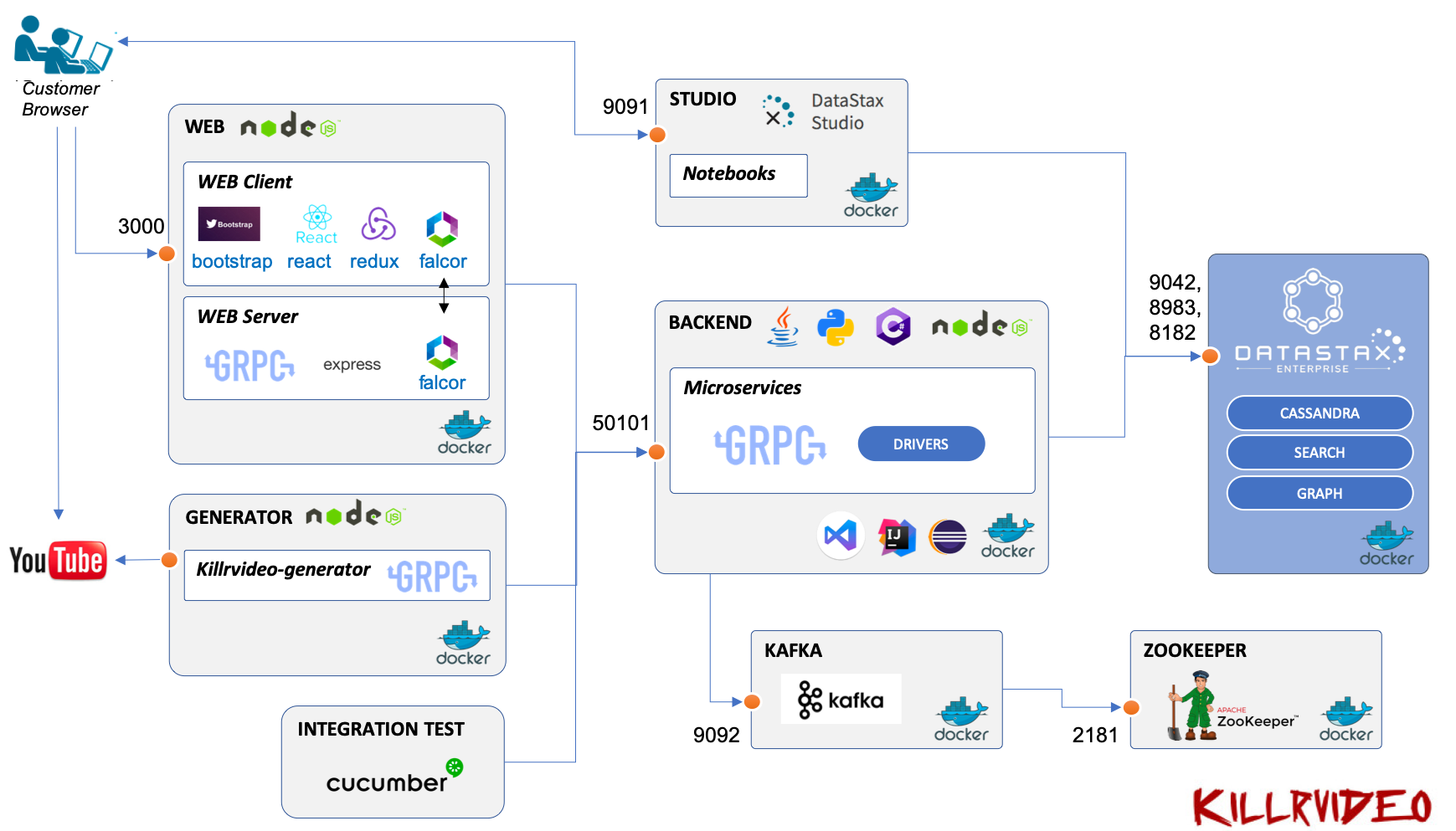High Level Architecture Overview
KillrVideo is a video sharing web application. As such, it's got a tiered setup that's pretty common for web applications:
- Web : The web UI that runs in a browser and is interacted with by the user and send requests to the backend
- Microservices Tier: A tier of independent services that house the data and the logic for the features and functionality of the site.
- Data Tier : DataStax Enteprise server will persist all informations required by the application.
We'll get into the details of how these tiers are actually implemented in the next section, but first let's take a look to an overall architecture diagram. Each compoment is deployed as Docker container.

| Name | Technology | Execution | Description |
|---|---|---|---|
| WEB | Node.js | Docker | The web UI of the application. |
| STUDIO | --- | Docker | The notebook-oriented developer tool provided by Datastax for developers |
| SERVICES | Node.js, Java, Python, C# | IDEs for dev and Docker for production | Business logic of the application, provides services for the UI and sample code to use DSE (Cassandra, Search, Graph) in multiple use cases. Services are exposed via gRPC |
| GENERATOR | Node.js | Docker | Job scheduled by vacation to collect some new videos from Youtube and saving them (through SERVICES) |
| INTEGRATION TESTS | Java | IDE(s) | Cucumber integration tests call GRPC services and testing expected behavior |
| DSE | --- | Docker for local development, DataStax Constellation for dev/live sites | Provides Cassandra, Search, Graph |
| KAFKA | --- | Docker | Some service implementations use Kafka for event, see Pub-Sub Messaging for |
| ZOOKEEPER | --- | Docker | Used by Kafka to store configuration data |
Web Tier
it's got a tiered setup that's pretty common for web applications:
- Web Client: The web UI that runs in a browser and is interacted with by the user. It sends requests to a Web Server (via HTTP, web sockets, etc.)
- Web Server: Serves up static assets for the client (i.e. JavaScript, CSS, images) and responds to requests from the Web Client by routing them to the appropriate service(s) on the backend.
Microservices Tier
KillrVideo uses a microservices style architecture where the site is broken up into multiple smaller services where each service is responsible for providing the functionality for a specific feature. This is the current list of services and the functionality they are responsible for:
| Service Name | Description | Used Workloads |
|---|---|---|
| Comments | Allows users to comment on videos and keeps track of those comments. | Cassandra |
| Ratings | Allows users to rate videos (on a scale of 1-5) and keeps track of those ratings. | Cassandra |
| Search | Indexes the available videos for searching by keyword and provides search suggestions (i.e. typeahead) support. | Cassandra,Search |
| Statistics | Keeps track of statistics for videos like how many times they've been played back. | Cassandra |
| Suggested Videos | Provides suggestions for videos similar to another video as well as personalized video suggestions for a particular user. | Cassandra, Search, Graph |
| Uploads | Allows users to upload videos to the site and handles converting uploaded video files to a format that's compatible with the site. | Cassandra |
| User Management | Manages user accounts including signing up and logging in/out. | Cassandra |
| Video Catalog | Keeps track of all the videos available for playback and the details of those videos (i.e. title, description, etc.) | Cassandra |
Each of these services is designed to be completely independent and not have a dependency on any other service being available to do its job. What does this mean in practice? That the implementations of our services shouldn't be making calls to other service APIs in order to do their work when at all possible. F So if we don't want our services directly calling other service APIs, how will the services interact with each other?
Events for Service Collaboration
In KillrVideo we've chosen to use events for collaboration between services rather than having services calling each other directly. Each service is for publishing events about interesting things that happen inside of them. Other services can then subscribe to any events they are interested in and react accordingly.
An Example from KillrVideo
Whenever a new YouTube video is added to the video catalog, the Video Catalog service publishes a
YouTubeVideoAddedevent. That event contains some of the details of the video that was added (like it's id, name, description, etc.). Other services can (and do) subscribe to this event if they are interested. For example, the Search service might want to add the video to its index so the video starts showing up in search results. Or the Suggested Videos service may want to figure out what other videos are similar to that one so it can offer suggestions.
If services are publishing events and possibly subscribing to them as well, this implies that we'll need some sort of mechanism for doing Publish-subscribe messaging. We'll cover the specifics of actually implementing pub-sub shortly.